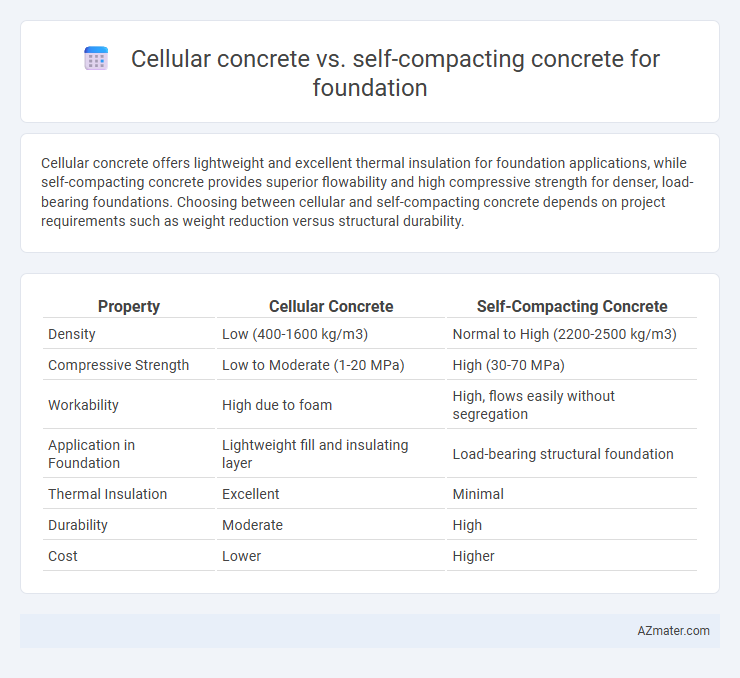Cellular concrete offers lightweight and excellent thermal insulation for foundation applications, while self-compacting concrete provides superior flowability and high compressive strength for denser, load-bearing foundations. Choosing between cellular and self-compacting concrete depends on project requirements such as weight reduction versus structural durability.
Table of Comparison
| Property | Cellular Concrete | Self-Compacting Concrete |
|---|---|---|
| Density | Low (400-1600 kg/m3) | Normal to High (2200-2500 kg/m3) |
| Compressive Strength | Low to Moderate (1-20 MPa) | High (30-70 MPa) |
| Workability | High due to foam | High, flows easily without segregation |
| Application in Foundation | Lightweight fill and insulating layer | Load-bearing structural foundation |
| Thermal Insulation | Excellent | Minimal |
| Durability | Moderate | High |
| Cost | Lower | Higher |
Introduction: Cellular Concrete vs Self-Compacting Concrete
Cellular concrete is a lightweight material characterized by its air-entrained structure, reducing density while maintaining thermal insulation and fire resistance, making it ideal for foundation backfill and void filling. Self-compacting concrete (SCC) is designed to flow under its own weight, providing high fluidity and excellent workability without segregation, ensuring uniform compaction in complex foundation forms. Comparing cellular concrete to SCC highlights the differences in density, compressive strength, and application techniques critical for foundation performance and durability.
Composition and Material Properties
Cellular concrete is composed of cement, water, and pre-formed foam, resulting in a lightweight, highly insulating material with low density and high porosity, which enhances its thermal and acoustic properties. Self-compacting concrete contains a higher proportion of fine aggregates, superplasticizers, and viscosity-modifying admixtures, enabling it to flow and consolidate under its own weight without segregation, offering high compressive strength and durability. The choice between the two depends on required load-bearing capacity and insulation needs, with cellular concrete favored for lightweight insulating foundations and self-compacting concrete for high-strength structural bases.
Workability and Ease of Placement
Cellular concrete offers superior workability due to its lightweight, flowable consistency that allows easy pumping and filling of complex foundation forms with minimal vibration. Self-compacting concrete excels in ease of placement by flowing under its own weight to fill intricate reinforcement spaces without segregation or honeycombing, reducing labor and time in foundation construction. Both materials improve foundation quality through enhanced adaptability, but cellular concrete's reduced density significantly lowers structural load while self-compacting concrete provides higher strength and durability.
Strength Characteristics
Cellular concrete exhibits lower compressive strength, typically ranging from 1.0 to 8.0 MPa, making it suitable for lightweight, non-structural foundation applications where insulation and load reduction are priorities. Self-compacting concrete (SCC) offers higher strength characteristics, with compressive strengths often exceeding 30 MPa, enabling it to support significant structural loads in foundation elements. The enhanced flowability of SCC ensures uniform density and fewer voids, resulting in improved durability and load-bearing capacity compared to cellular concrete.
Durability and Longevity
Cellular concrete offers superior thermal insulation and lightweight properties that reduce stress on foundations, enhancing durability in environments prone to soil movement. Self-compacting concrete provides high strength and excellent flow characteristics, ensuring uniform compaction that minimizes voids and potential cracks, thus extending foundation longevity. Both materials improve foundation lifespan, but cellular concrete excels in insulation-related durability while self-compacting concrete is preferred for structural integrity and resistance to wear.
Thermal and Acoustic Insulation
Cellular concrete offers superior thermal insulation with its lightweight, aerated structure, reducing heat transfer and improving energy efficiency in foundations. Self-compacting concrete typically provides enhanced acoustic insulation due to its dense matrix, which better attenuates sound waves. For foundation applications where balancing thermal performance and soundproofing is critical, the choice depends on prioritizing thermal insulation (cellular concrete) or noise reduction (self-compacting concrete).
Cost Efficiency and Economic Factors
Cellular concrete reduces foundation costs through its lightweight properties, which lower transportation expenses and minimize heavy equipment needs, resulting in faster installation and labor savings. Self-compacting concrete, though generally higher in material cost due to admixtures, decreases labor costs by eliminating the need for vibration and ensuring consistent quality, reducing rework expenses. Evaluating project scale and site conditions is crucial, as cellular concrete offers significant savings in large, less accessible projects, while self-compacting concrete excels in urban environments demanding precision and minimal labor time.
Environmental Impact and Sustainability
Cellular concrete significantly reduces environmental impact through its lightweight composition that uses less cement and incorporates recycled materials, leading to lower carbon emissions during production compared to traditional concrete types. Self-compacting concrete enhances sustainability by minimizing waste and labor through its flowable properties, enabling faster construction and reducing energy consumption on-site. Both materials offer distinct eco-friendly benefits for foundations, with cellular concrete excelling in resource efficiency and self-compacting concrete optimizing construction processes to support sustainable building practices.
Suitability for Different Foundation Types
Cellular concrete excels in lightweight foundation applications such as slab-on-grade or backfill due to its reduced density and thermal insulation properties, making it ideal for expansive or weak soils. Self-compacting concrete, with its high flowability and superior strength, suits complex reinforced foundations like pile caps and deep footings requiring precise placement and minimal vibration. Selection depends on structural load requirements and site conditions, where cellular concrete optimizes volume and weight, while self-compacting concrete ensures durability and structural integrity.
Conclusion: Selecting the Right Concrete for Foundations
Cellular concrete offers lightweight properties and excellent insulation, making it ideal for non-structural foundation elements requiring thermal efficiency and reduced load on soil. Self-compacting concrete provides superior flowability and compaction without vibration, ensuring dense, high-strength foundations with complex reinforcement layouts. Selecting the right concrete depends on specific foundation design requirements, load conditions, and project priorities such as thermal insulation versus structural performance.

Infographic: Cellular concrete vs Self-compacting concrete for Foundation
 azmater.com
azmater.com